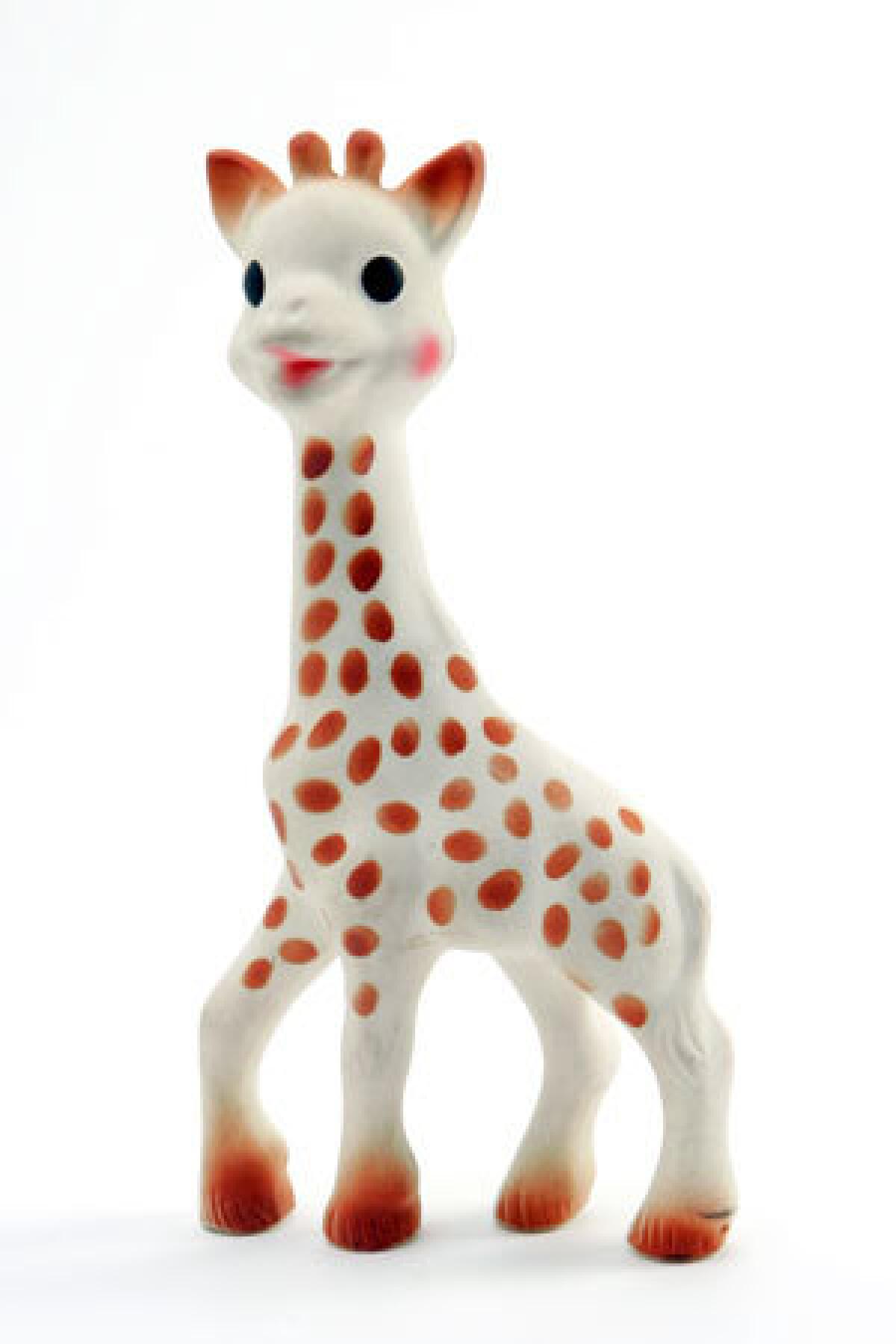How Sophie the giraffe became a status teether

- Share via
The second I saw her I was smitten. She stood 7 inches high with big, coal-black eyes, a blush of hot pink on each cheek and a little mouth parted to reveal a cheerful smile. I loved the rich caramel color of her spots, the jaunty bend of her front knee, the way her long, thin neck fit so perfectly in Ryu’s fat little hand. The texture of her body was soft like suede, and malleable enough for my friend’s 6-month-old to elicit a low, seductive squeak with just the slightest bit of pressure. I was desperate to buy her. For my son.
Little did I know that falling in love with this rubber giraffe was the equivalent of falling in love with that cute dress you hoped your friend had bought at Forever 21 but that turned out to be from Marc Jacobs. The toy that I so innocently admired was, in fact, a status teether.
She has a name, Sophie, and if you start asking around you’ll find that most new moms have at least heard of her, if they haven’t already bought her. Maybe they saw her in Us Weekly, clutched in the hands of Nicole Richie’s daughter, Harlow Madden, or maybe they saw Sophie back in 2004 being gnawed on by Kate Hudson’s son, Ryder Robinson (an early adopter). Perhaps they’ve gone to a birthday party or a play group where their little one encountered Sophie and was instantly fixated -- a story repeated in dozens of online reviews of the toy. Or possibly they’ve spotted her at a baby boutique (because you won’t find Sophie in the big-box stores). Since Amazon started selling her in 2008, she has consistently ranked in the top three most wished-for items in the baby store and has earned a 4 1/2 -star rating based on 273 reviews.
“I think the cuteness is what first attracts you,” said Cheryl Petran, chief operating officer of the Pump Station, a mini-chain popular with L.A. moms, “and then what you learn about it justifies the price.”
That’s the bummer about Sophie and why my son, Jonah, now almost 1 1/2 , never got his busy little hands on a Sophie of his own. With tax, the giraffe costs more than $25 in most stores. That’s about three times what a similar-sized teether toy might cost at Target.
My colleagues with no children or older ones couldn’t understand my Sophie love. Two co-workers said she looked like a dog’s chew toy. A friend expected her to be bigger. They didn’t know, or had forgotten, about the candy-colored, hard plastic monstrosities that make up the vast majority of baby toys on the market. Compared with them, Sophie seems sophisticated.
To defend myself, I started to rattle off Sophie stats to my colleague Robin Abcarian. “She’s organic; babies can chew on her hooves and her horns; she’s celebrity endorsed,” I said.
“You know way too much about this,” she said.
But isn’t knowing too much what being a mom is about these days? Even those of us who are trying not to obsess, who are trying to parent from the gut instead, still face hundreds of questions that ultimately say a lot about how parenting has changed -- and is changing. Which bottle to buy? Do we teach baby sign language? Why are we drawn to that pricey teether?
Part of the appeal of Sophie is her European lineage. She is from France (a sticker on her packaging depicts Sophie in front of the Eiffel Tower), created in 1961 by “a certain Monsieur Rampeau,” and she was an instant success in that country, where chewing on a Sophie has become a right of passage for French babies. Sophie didn’t come to America until 2000, when Helene Dumoulin-Montgomery began to import her. Dumoulin-Montgomery was a new mother in Orange County and a recent transplant from France, where she grew up with a Sophie of her own. (There she costs 6.90 euros before tax, about half the price in the U.S.)
Dumoulin-Montgomery drove from boutique to boutique, only to be rejected because of what was considered an outrageous price for a rubber toy. “I had to have a lot of faith in that giraffe,” she said.
Teri Weiss, owner of the Beverly Hills boutique Elegant Child, was one of the first to see Sophie’s potential.
“I knew I could sell it,” she said. She bought a few to put in the expensive baby baskets she assembles for celebrity parents. The toy was an instant hit, and soon Weiss was selling hundreds of Sophies a week. She saw a spike in sales each time a celebrity’s child was photographed chewing on Sophie, but the giraffe really started to take off in 2007, when hundreds of toys made in China were recalled because of lead-based paint.
“That’s when Sophie really started to make it,” Dumoulin-Montgomery said. “Sophie was already on the market, and the mom blogs were saying this is a safe toy.”
Demand for the toy has continued to grow ever since. Last year, Dumoulin-Montgomery said she sold 100,000 Sophies. Weiss said she never likes her Sophie stock to drop below 240.
Sophie arrives with a pamphlet that explains she is made of “100 percent natural rubber derived from the sap of the Hevea tree.” Her spots are rendered in food-grade paint, so moms don’t worry if baby manages to suck them off, as my friend’s son did. (“We have an albino giraffe now,” she said.)
Sophie’s French origin gives her the same je ne sais quoi as big scarves and pegged jeans, and it frees her from the stigma of being “made in China” -- a radioactive phrase that evokes not only cheapness, but also fears of toxicity.
Recently, I brought a borrowed Sophie to my son’s day care. The director looked confused when I revealed the price. She kept wanting to know if the toy did anything. I explained about the natural rubber, the thin neck easy for grasping, the horn nubs on her head that supposedly soothe babies’ gums. “But it’s a squeezy toy, right?” one of the teachers said. “You can get that at the 99 cent store.”
I felt a little sheepish for even wanting a Sophie, but I’ve come to realize that if you can’t understand why someone might spend $300 on a designer purse when there are fine bags at Target for $30, then you probably can’t understand why someone might buy this rubber giraffe. To some moms, Sophie is simply prettier, softer and cooler than any other teether. If my thrifty husband hadn’t stopped me, my son might have an albino Sophie too.
Even in this era of scrutinized budgets, it is still possible to talk oneself into buying a Sophie. Thousands of parents have.
“People with very little money are willing to spend money on this thing,” Weiss said, adding that many of her sales are made to people whose credit cards don’t go through the first time. “It isn’t a $1,000 stroller. For $20, they can have what the movie stars have.”
Two friends who did buy Sophie are stay-at-home moms. One is married to an art history grad student, the other to a struggling musician. Neither is rolling in cash, but for new moms, there is often a way to justify something you want, especially if it’s for your baby.
“Yeah, he loves it,” the musician’s wife told me. “But for how much this cost, Ryu’s going to take this to college with him.”
This column on parenting trends and child-rearing fads will appear monthly. Submit ideas to [email protected].







